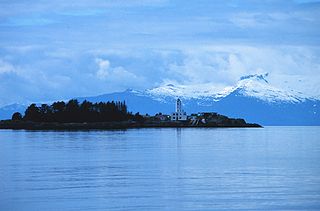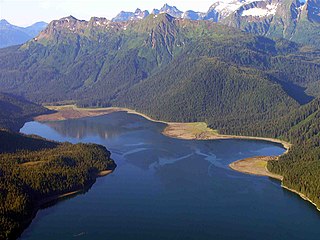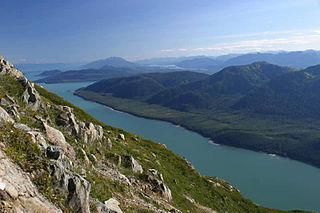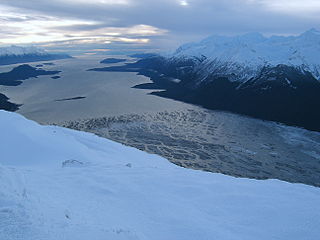Related Research Articles

Captain George Vancouver was a British Royal Navy officer best known for his 1791–1795 expedition, which explored and charted North America's northwestern Pacific Coast regions, including the coasts of what are now the Canadian province of British Columbia as well as the US states of Alaska, Washington, Oregon, and California. The expedition also explored the Hawaiian Islands and the southwest coast of Australia.

Frederick Sound is a passage of water in the Alexander Archipelago in Southeast Alaska that separates Kupreanof Island to the south from Admiralty Island in the north.

Admiralty Island is an island in the Alexander Archipelago in Southeast Alaska, at 57°44′N134°20′W. It is 145 km (90 mi) long and 56 km (35 mi) wide with an area of 4,264.1 km2 (1,646.4 sq mi), making it the seventh-largest island in the United States and the 132nd largest island in the world. It is one of the ABC islands in Alaska. The island is nearly cut in two by the Seymour Canal; to its east is the long, narrow Glass Peninsula. Most of Admiralty Island—955,747 acres (3,868 km2)—is protected as the Admiralty Island National Monument administered by the Tongass National Forest. The Kootznoowoo Wilderness encompasses vast stands of old-growth temperate rainforest. These forests provide some of the best habitat available to species such as brown bears, bald eagles, and Sitka black-tailed deer.

Lynn Canal is an inlet into the mainland of southeast Alaska.

Stephens Passage is a channel in the Alexander Archipelago in the southeastern region of the U.S. state of Alaska. It runs between Admiralty Island to the west and the Alaska mainland and Douglas Island to the east, and is about 170 km (105 mi) long. Juneau, the capital of Alaska, is near the north end, on Gastineau Channel.

Gastineau Channel is a channel between the mainland of the U.S. state of Alaska and Douglas Island in the Alexander Archipelago of southeastern Alaska. It separates Juneau on the mainland side from Douglas, on Douglas Island. The first European to sight the channel was Joseph Whidbey whilst serving on the Royal Navy's Vancouver Expedition early in August 1794, first from the south and later from the west. It was probably named for John Gastineau, an English civil engineer and surveyor.

Juan Francisco de la Bodega y Quadra was a Spanish Criollo naval officer operating in the Americas. Assigned to the Pacific coast Spanish Naval Department base at San Blas, in Viceroyalty of New Spain, he explored the Northwest Coast of North America as far north as present day Alaska. Bodega Bay in California is named for him.

Chilkat Inlet is an inlet in Lynn Canal in the Southeast region of the U.S. state of Alaska that includes the delta for the Chilkat River and borders Haines and the Chilkat Peninsula. It was first charted in 1794 by Joseph Whidbey, master of HMS Discovery during George Vancouver's 1791–1795 expedition.

The Chilkat Peninsula is a peninsula in Lynn Canal, Southeast Alaska that divides the Chilkoot and Chilkat Inlets and divides the Chilkat and Chilkoot watersheds. The peninsula extends into Lynn Canal as well. It was first charted in 1794 by Joseph Whidbey, master of HMS Discovery during George Vancouver's 1791–1795 expedition.

Chilkoot Inlet is an inlet in the Southeast region of the U.S. state of Alaska, located on the eastern side of the Chilkat Peninsula in Lynn Canal. Chilkoot Inlet is the terminus of the Chilkoot River and its watershed, and also home to Lutak, Alaska. It was first charted in 1794 by Joseph Whidbey, master of HMS Discovery during George Vancouver's 1791–1795 expedition.

Lincoln Island is a wooded island in Lynn Canal in Alaska, United States. Located at 58°29′41″N134°59′40″W, the island is one kilometer northwest of larger Shelter Island and some 200 meters southeast of smaller Ralston Island. It is part of the Juneau City and Borough. The first European to sight the island was Joseph Whidbey, master of HMS Discovery during George Vancouver's 1791–1795 expedition, in 1794. It was named in 1868 by Commander R. W. Meade, USN, presumably for Abraham Lincoln.

Anvil Island is the third-largest of the islands in Howe Sound, British Columbia, Canada, and the northernmost of the major islands in that sound. It is part of West Howe Sound, Electoral Area F within the Sunshine Coast Regional District (SCRD) on the Sunshine Coast.

Shelter Island is an island in the Alexander Archipelago, southeast of Lincoln Island and northwest of Juneau, Alaska, U.S. It trends northwest between Favorite and Saginaw channels. It was named in 1869 by Commander R. W. Meade of the United States Navy. The first European to sight the island was Joseph Whidbey, master of HMS Discovery during George Vancouver's 1791–95 expedition, in 1794.
Favorite Channel is a channel in Southeast Alaska, northwest of Juneau, Alaska, United States. It is 25 kilometres (16 mi) long, extending northwest from Stephens Passage to Lynn Canal, separating Lincoln and Shelter islands from the mainland to the east. It was named in 1880 by U.S. Navy officers after the 80-foot (24 m) steamboat Favorite, which was chartered by the Navy for surveying work in Alaska, later being used to carry out trading and fishing for the herring plant at Killisnoo. The first European to traverse and chart the channel was Joseph Whidbey, master of HMS Discovery during George Vancouver's 1791–95 expedition, in 1794.

Seymour Canal is an inlet penetrating deep into the southeastern part of Admiralty Island, Southeast Alaska, United States. The inlet was first charted in 1794 by Joseph Whidbey, master of HMS Discovery during George Vancouver's 1791–95 expedition. Vancouver later named it "Seymour's Channel". Two large islands are located within it: Swan Island to the north, and Tiedeman Island just to its south.

The Glass Peninsula is a peninsula extending southeast from Admiralty Island, between Seymour Canal and Stephens Passage, Southeast Alaska, United States. It was named by the United States Coast and Geodetic Survey for United States Navy Commander Henry Glass, who had made surveys in the area in 1881. It was first charted in 1794 by Joseph Whidbey, master of HMS Discovery, during George Vancouver's 1791–1795 expedition.
Swan Island is an island in the Alexander Archipelago, east of Admiralty Island, near the head of Seymour Canal, Southeast Alaska, United States. To its south is Tiedeman Island. It was named in 1890 by Lieutenant Commander Mansfield of the United States Navy. The first European to discover and chart the island was Joseph Whidbey, master of HMS Discovery during George Vancouver's 1791–1795 expedition, in 1794.
Tiedeman Island is an island in the Alexander Archipelago, east of Admiralty Island, about two-thirds up from the entrance of Seymour Canal, which is a large inlet in the Admiralty Island National Monument and Wilderness in Southeast Alaska, United States. To its north is Swan Island. It was named by William Healy Dall of the U.S. Coast and Geodetic Survey, and published in the 1883 Coast Pilot. The first European to discover and chart the island was Joseph Whidbey, master of HMS Discovery during George Vancouver's 1791–1795 expedition, in 1794. The island features nesting habitat for a large number of bald eagles and is part of the Seymour Canal Eagle observation area, used for long-term observation of bald eagles. Old-growth forest covers 30% of the island. There is one lake on the island. Peak elevation is less than 200 meters.
Sullivan Island is an island in Lynn Canal, southwest of Chilkat Island, Southeast Alaska, United States. It was named in 1869 by Commander R. W. Meade, USN, for the master of the schooner Louisa Downs, which had wrecked on the island in 1867. The Tlingit name for the island is "Schikuk". The first European to discover and chart the island was Joseph Whidbey, master of HMS Discovery during George Vancouver's 1791–1795 expedition, in 1794.
Ralston Island is a small island in the Alexander Archipelago, northwest of Lincoln Island and northwest of Juneau, Alaska, United States. It was named in 1868 by Commander R. W. Meade, USN, for W. C. Ralston; the name was published by the U. S. Coast and Geodetic Survey in the 1883 Coast Pilot. The first European to sight the island was Joseph Whidbey, master of HMS Discovery during George Vancouver's 1791–95 expedition, in 1794.
References
- ↑ The small city of Coevorden in the eastern Netherlands.
- ↑ Vancouver, George, and John Vancouver (1801). A voyage of discovery to the North Pacific ocean, and round the world. London: J. Stockdale.
{{cite book}}: CS1 maint: multiple names: authors list (link)